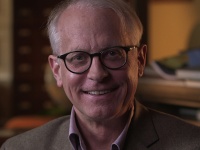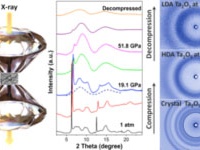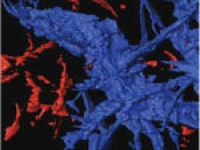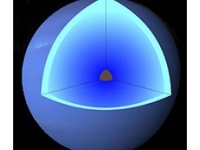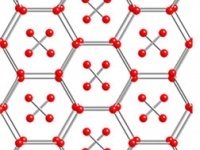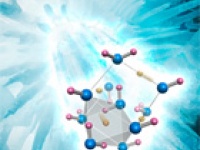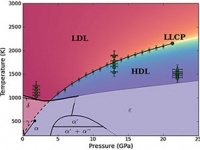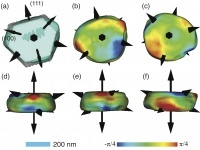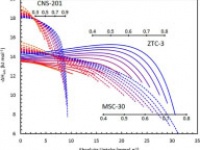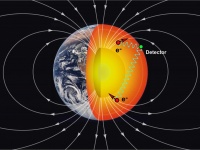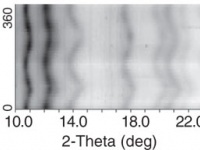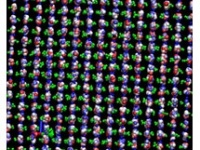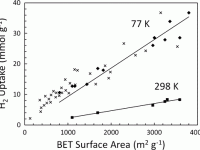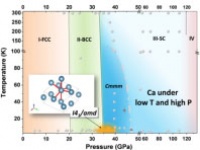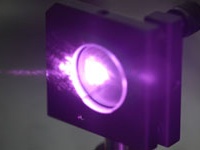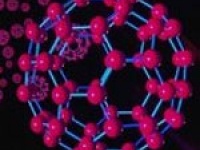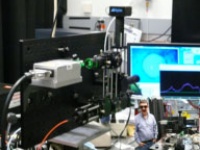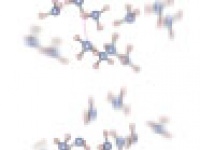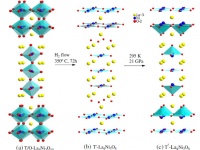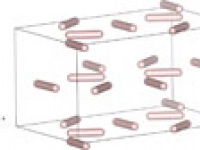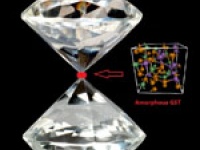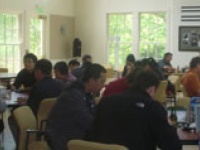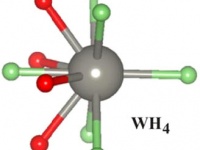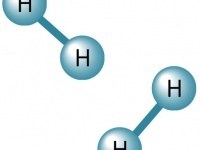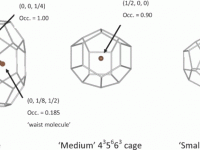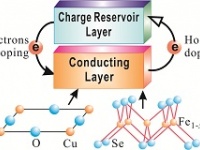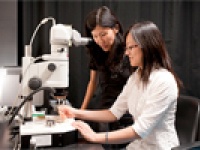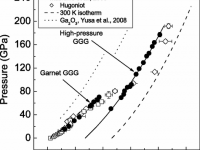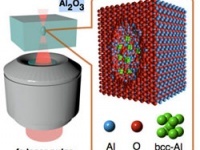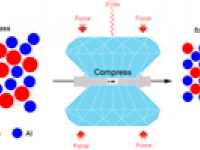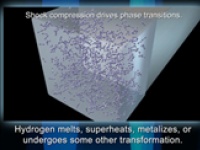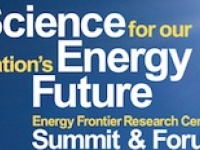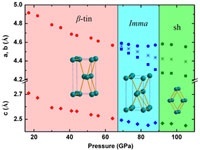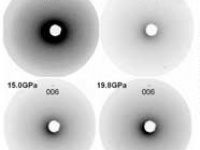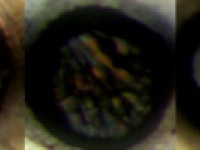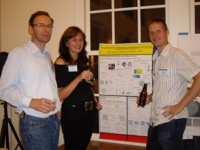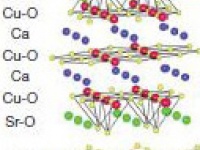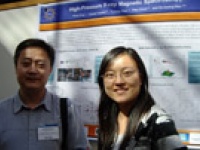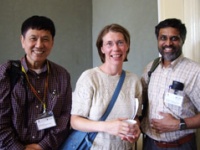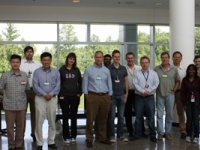Archived Articles
EFree Director Russell J. Hemley presented the George C. Pimentel Lecture at the University of California, Berkeley on Nobember 18, 2014. The talk was titled "New Views of Structure and Bonding in Extreme Environments."
A paper by EFree Scientists Malcolm Guthrie and Reinhard Boehler, along with colleagues from HPCAT and Oak Ridge National Laboratory has been named as one of the Taylor & Francis Materials Science Top 10 for 2013.
The paper, published in High Pressure Research, reported reports new conical designs for the diamond anvil cell. These designs...
EFree partners at the University of Texas at Austin, along with collaborators from the Chinese Academy of Sciences and HPCAT published a paper in the Proceedings of the National Academy of Science reporting their new findings on the magnetic and structural transitions in iron-based BaFe2As2 superconductor at extreme environments.
...
Amorphous functional nanomaterials have drawn a lot of attention due to their unusual physical properties and numerous important applications. Pressure-induced amorphization (PIA) is considered to be a potential way to synthesize new amorphous materials with novel properties. To date, few studies have reported the improved properties of materials...
Researchers from Stanford University, including EFree Scientist Wendy Mao and her student Crystal Shi, the Geophysical Laboratory, HPSynC, and HPCAT performed experiments recreating to the varying extreme conditions of pressure and temperature within the early Earth. Their results support the theory expounded nearly a century ago that the Earth...
Hydrocarbons from the Earth make up the oil and gas that heat our homes and fuel our cars. The study of the various phases of molecules formed from carbon and hydrogen under high pressures and temperatures, like those found in the Earth's interior, helps scientists understand the chemical processes occurring deep within planets, including Earth....
Hydrogen is deceptively simple. It has only a single electron per atom, but it powers the sun and forms the majority of the observed universe. As such, it is naturally exposed to the entire range of pressures and temperatures available in the whole cosmos. New theoretical work at the Geophysical Laboratory provides surprising insight into the...
A team led by EFree Chief Scientist Malcolm Guthrie applied neutron technique to Ice VII, a dense form of ice, and made a striking discovery about how ice behaves under high pressure. They obtained the first glimpse of the dissociation of water molecules under unprecedented pressure of over 50 GPa (500,000 times atmospheric pressure). Observation...
Understanding polymorphism in liquids provides key insights into the complex nature of the liquid state, and may now be studied in detail as a result of advances in synchrotron x-ray diffraction techniques. The observation of a liquid-liquid transition in a material having two distinct liquid phases of differing density is experimentally...
A team led by Wenge Yang (HPSynC) and including researchers from Carnegie, the Advanced Photon Source, and University College London has made a major breakthrough in measuring the structure of nanomaterials under pressures. For the first time, a way to get around the severe distortions of high-energy X-ray beams that are used to image structures...
Methane is a proven fuel, and its importance will grow with new sources of supply. The storage of methane gas for mobile vehicles could benefit from increased volumetric energy density at a given pressure. One approach is physisorption, a relatively weak, non-chemical binding of molecules to the surface of an adsorbent material. The quantity of...
EFree Partner Jung-Fu Lin and colleagues from The University of Texas at Austin and Amherst College have described a new technique that might one day reveal the composition and characteristics of the deep Earth in higher detail than ever before. However, the technique relies on the long-range electron spin-spin interaction, a fifth force of nature...
Understanding the behavior of nickel nanocrystals at high pressure is the focus of current research by a group of scientists from Carnegie, UC-Berkely, LBNL, UC-Santa Cruz, and Southern University, including EFree Director Ho-kwang Mao (Carnegie). Recent findings by this group could help physicists and engineers create stronger, longer-lasting...
A new efficient way to pump heat using crystals has been discovered by Carnegie Summer Scholar Maimon Rose (University of Chicago) and Carnegie Staff Scientist Ronald E. Cohen. The crystals can pump or extract heat, even on the nanoscale, so they could be used on computer chips to prevent overheating or even meltdown, which is currently a major...
Compact hydrogen storage that is effective and practical remains an important obstacle to realizing a hydrogen energy economy. Physisorption of hydrogen on the surface of an adsorbent material is a promising solution. High pressure can be used to reach reasonable hydrogen densities, but few thermodynamic studies of hydrogen physisorption have been...
Studies of Ca at low temperatures and high pressures are important in order to understand its superconductivity. Ca holds the record for the highest superconducting critical temperature (Tc = 26 K) among elemental materials. Moreover, Ca serves as an active test case of modern theories and experiments on crystal structure and stability. In high-...
Bonding properties and phase transitions in hydrogen under extreme conditions are a central focus of EFree. Hydrogen at high pressure may be a superconductor or a super fluid, and is a grand challenge problem within EFree. Furthermore, the development of enabling technologies for the study of hydrogen rich-systems under extreme conditions is also...
EFree held its 4th Annual Meeting on September 12-13, 2012, at the Geophysical Laboratory in Wasington, DC. Presentations on research highlights and progress will be given by senior investigators, postdocs and students who members of the Center.
Agenda
A team of scientist led by EFree's Lin Wang (HPSynC) and including Wenge Yang (HPSynC), Zhenxian Liu (U2A), Stanislav Sinogeikin (HPCAT), Yue Meng (HPCAT), and Wendy Mao (Stanford), along with collaborators from Jilin University, the University of Nebraska, and Argonne National Laboratory, has observed a new form of very hard carbon clusters,...
A remotely controlled gas loading system has been built and tested at the HPSynC sample preparation laboratory at the Advanced Photon Source, Argonne National Laboratory. It is available for loading hydrogen, helium or neon (other gases are possible by special arrangement). The gear boxes are made for symmetrical and panoramic cells. In addition,...
Most ammonia is used for fertilizers, but it has also been proposed as a potential carbon-free fuel source. Characterizing structure, in particular in the liquid state, reveals the role of intermolecular bonds in dictating macroscopic properties. EFree Chief Scientist Malcolm Guthrie and other EFRC-funded researchers at the SNAP diffractometer at...
T’-La4Ni3O8 , a T’-type nickelate compound with mixed-valence Ni1+/Ni2+ ions, the analog of the high-Tc cuprates with mixed-valence Cu2+/Cu3+,has attracted much interest. At ambient pressure, T’-La4Ni3O8 undergoes an abrupt phase transition at Tt=105K, confirmed by transport and magnetic properties measurements. However, no long-range spin...
Hydrogen, the most abundant and lightest element in the universe, is the object of fundamental physics research focusing on its transition to a metallic phase. For decades, it has been predicted that metallization in pure hydrogen gives rise to superconductivity with very high transition temperature.
Recently, the existence of metallic solid...
A collaborative experimental effort with Carnegie researchers has discovered unknown properties of a computer memory material that will allow for faster data transfer with a higher capacity of data stored.
The research focused on a material already in use with rewritable optical media composed of germanium, antimony and tellurium Ge2Sb2Te5 (GST...
On April 21, 2012 a workshop on Superconductivity and Strongly Correlated Materials was held at Carnegie's Geophysical Laboratory in Washington, DC. The workshop was co-sponsored by EFree and The Swedish Foundation for International Cooperation in Resarch and Higher Education (STINT). It touched on superconductivity, strongly correlated...
Tungsten gaskets surrounding hydrogen in diamond anvil cells were observed to react with hydrogen under pressure to form WHn compounds. EFree Parnters from Cornell and Carnegie employed density functional theory to map out possible stable structures with different n-values (n=1-6 and 8) followed by additional experiments to validate results of the...
Even though hydrogen is the most abundant element in the universe, an understanding of its properties under extreme pressure and temperature conditions is not yet complete. Ultimately, the fundamental physics behind the behavior of this seemingly simple element can inform and expand our understanding of matter as a whole. New work from Carnegie...
Natural gas hydrates are an unusual form of ice-like material where a hydrogen-bonded network of water molecules traps methane molecules inside a cage-like framework. Deposits of these hydrates are stabilized by deep-ocean pressures in such vast amounts that they have long been considered to be a potential fuel source. However, a critical issue...
New experiments set the record of the superconducting transition temperatures for a new family of iron-based selenide superconductors. These materials were recently found to superconduct below 30 Kelvin, but their transition temperatures decline until approaching absolute zero temperature with the application of pressure. Now Carnegie scientists ...
Carbon has long been a rich and active research area. It offers exciting discoveries of new allotropes including both crystalline and disordered structures such as buckyballs, carbon nanotubes, graphene, and diamond-like amorphous carbon with numerous and exciting potential in technological applications. However, the amorphous allotrope of...
Single crystal gallium gadolinium garnet (Gd3Ga5O12 or GGG), which crystallizes in the garnet structure at ambient conditions, was observed to transform to a high-pressure phase at 88 GPa after laser-heating at 1500 K within a diamond anvil cell. The new phase is highly incompressible, stiffer than shock-compressed sapphire and diamond above 170...
Aluminum is one of the common materials which we use daily and holds faced-center-cubic structure at ambient environment. Theoretical calculation has predicted the possible phase transition of fcc to hcp, and hcp to bcc under high pressures at 120 GPa and over 380 GPa, respectively, but so far only the first transition has been observed...
The 3rd EFree Annual Meeting was held at Carnegie's Geopysical Laboratory from Septembe 16-17, 2012. Over 60 of EFree's principal investigators, postdocs, and graduate students presented updates on their research and inspired others to collaborate more fully within the Center's nine member universities, four national labs and Carnegie.
The...
A research team including EFree Director Ho-Kwang Mao (Carnegie), observed that crystalline long-range topological order can form in metallic glass made from Ce and Al. Their research reveals the possibility of creating a metallic glass that is organized on a larger scale. The team determined that the atomic structures of Ce and Al prevent the...
Cornell University will host six workshops on June 6-30, 2011 focusing on the assessment of science at the hard x-ray diffraction limit. EFree members are organizing and participating in this important workshop. This workshop is a collaboration between CHESS, DESY, the Photon Factory, and SSRL in order to study science that can be done with...
A team of scientists Lawrence Livermore National Laboratory scientists, Jonathan Crowhurst, Mike Armstrong, Joe Zaug, and Kwei-Yu Chu, produced a video on “The Behavior of Hydrogen Under Extreme Conditions on Ultrafast Timescales.” It is an impressive illustration of shock wave compression of solid precompressed hydrogen involving compression,...
The U.S. Department of Energy held an Energy Frontier Research Center (EFRC) Summit & Forum on May 25-27, 2011. The Summit brought together scientists and energy policy leaders with the goal of exploring the challenges and opportunities in applying America's extraordinary scientific and technical resources to the country's critical energy...
Elemental Ge is fundamental in condensed matter physics. Like the lighter elements in its family in the Periodic Table, C and Si, Ge crystal structure changes in Ge from the semiconducting diamond-type structure to metallic phases with increasing coordination. As such, accurate determination of the structures and transition pressures is an...
For the first time, scientists at HPSynC were able to demonstrate the feasibility of applying a nano/submicron focused monochromatic x-ray beam to study nanoscale single crystalline phases in diamond anvil cells at high pressures. Results of the study led by HPSynC scientist Lin Wang, indicate that the distribution and morphology of each...
Lithium is the lightest metal in the periodic table, the least dense solid element at room temperature, and has only 3 electrons per atom. Under pressure, lithium behaves in a manner that’s anything but simple. Above modest pressures of around 40 GPa, not only does it melt at room temperature, but then refuses to freeze down to 190 K, some 45 K...
Winston Liu, a Montgomery Blair High School student and intern Carnegie, has been named a semifinalist in the Siemens Foundation’s 2010 competition in Math, Science, and Technology. Liu's study on “Ethane-hydrogen systems under high pressure” is an energy-related project which helps clarify phase behavior in the hydrogen-hydrocarbon family of...
For the first time scientists have been able to watch nanoparticles grow from the earliest stages of their formation. The breakthrough was made possible by high-brightness and high-energy synchrotron radiation techniques developed in part by HPSynC. The work should lead to new ways to control nanocrystal growth, a result that will affect...
The 2nd Annual EFree Meeting was held on 24-25th September 2010, at the Carnegie Institution of Washington's Geophysical Laboratory Campus in Washington, DC. The meeting was well attended. 17 invited talks were presented, including updates by EFree Partners from Universities and National Labs, and by EFree Coordinators from Carnegie.
Progress...
A new theoretical and experimental study of the electronic structure and equation of state of crystalline palladium nitride has been published in Physical Review B. The authors find the compound has a pyrite structure above 58 GPa. This structure is metastable to 11 GPa. The Heyd-Scuseria-Ernzerhof exchange-correlation functional (HSE06),...
Finding a way to achieve a higher transition temperature, Tc, of a superconductor than it already has for the energy application is a grand challenge. Currently, copper oxides remain the superconducting materials having the highest Tc both at ambient condition and under pressure. EFree neutron scientist Xiao-Jia Chen (Carnegie), and collaborators...
Li Zhang (Carnegie) reports on the synthesis of optically transparent, mesoporous, monolithic diamond from periodic mesoporous carbon CMK-8 at a pressure of 21 GPa. These findings point toward a highly mechanically and chemically stable ultra-hard mesoporous material. Zhang is the lead author of the article "Catalyst-free synthesis of transparent...
EFree Director Ho-kwang Mao delivered the plenary talk, "High-pressure science and technology of the 21st century," at the International Center for Materials Research (ICMR) conference on Pressure Effects on Materials held at UC Santa Barbara on August 22-28, 2010.
Three Carnegie scientists and EFree partners also gave invited talks:Russell...
EFree Director Ho-kwang Mao presented a plenary talk at the 2010 European High Pressure Research Group (EHPRG) conference held in Uppsala. He is pictured at left with Carnegie Research Scientist Maddury Somayazulu and former Carnegie postdoc Olga Degtyareva, the recipient of 2010 EHPRG Award. Mao's talk was titled "High Pressure Science and...
On May 26th 2010, EFree Partners attended a meeting at the Spallation Neutron Source at Oak Ridge National Laboratory in TN. Focusing on developments of the SNAP high pressure diffractometer. This meeting was instigated by SNAP beamline scientist (and EFree Partner) Chris Tulk, along with EFree Chief scientist Malcolm Guthrie and was hosted by...
Jung-Fu Lin and Roger Gary have successfully built a HP gas loading system at UT-Austin's Mineral Physics Laboratory at the Jackson School of Geosciences. It is packed into a small cart for flexibility and safety.
Pictured at left are Lin and Gary with their gas loading system.
More information:
http://www.geo.utexas.edu/faculty/lin/default....

